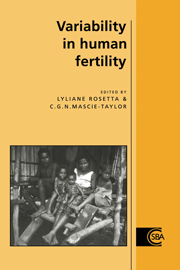Book contents
- Frontmatter
- Contents
- List of contributors
- 1 Introduction: the biological anthropological approach
- PART I HORMONAL ASPECTS OF FERTILITY REGULATION
- 2 The hypothalamo-pituitary regulation of the reproductive function: towards an increasing complexity
- 3 Lactation, condition and sociality: constraints on fertility of non-human mammals
- 4 Evidence for interpopulation variation in normal ovarian function and consequences for hormonal contraception
- PART II INTERPOPULATION VARIABILITY
- PART III METABOLIC AND ENERGETIC ASPECTS OF REGULATION
- Index
3 - Lactation, condition and sociality: constraints on fertility of non-human mammals
Published online by Cambridge University Press: 03 February 2010
- Frontmatter
- Contents
- List of contributors
- 1 Introduction: the biological anthropological approach
- PART I HORMONAL ASPECTS OF FERTILITY REGULATION
- 2 The hypothalamo-pituitary regulation of the reproductive function: towards an increasing complexity
- 3 Lactation, condition and sociality: constraints on fertility of non-human mammals
- 4 Evidence for interpopulation variation in normal ovarian function and consequences for hormonal contraception
- PART II INTERPOPULATION VARIABILITY
- PART III METABOLIC AND ENERGETIC ASPECTS OF REGULATION
- Index
Summary
Introduction
A major focus of research in mammalian behavioural ecology has been on the factors controlling reproductive success among different individuals (e.g. Clutton-Brock, 1988). This concept of ‘ reproductive success ’, defined as the number of offspring who survive to breeding age, is central, in that it lies at the heart of explanations about why individuals vary in their behaviour associated with courtship, access to mates and parenting, and ultimately influences patterns of mating systems and sociality. Reproductive success is thus a measure of individual fitness, containing a number of components and allowing for the assessment of sources of variance. The main elements contributing to reproductive success are age-specific fertility and fecundity, offspring survival and breeding lifespan (Table 3.1). As such, an understanding of the constraints on fertility is crucial to building a complete picture of behaviour in relation to reproduction, and in descriptions of individual variation and its sources.
However, mammalian field studies tend to be observational rather than invasive, and only a limited understanding of fertility mechanisms exists. The majority of studies produce correlational findings and causal links remain speculative. Behavioural physiology on wild species is in its infancy, and of necessity, we must draw on captive or domestic species in order to gain a broader perspective on fertility mechanisms. This aside, a sufficient number of studies on reproductive variation exist for some general observations to be made about the links between individual characteristics, behaviour and fertility. The major factors highlighted as influencing fertility among non-human mammals are, unsurprisingly, similar to those seen in humans.
- Type
- Chapter
- Information
- Variability in Human Fertility , pp. 25 - 45Publisher: Cambridge University PressPrint publication year: 1996
- 2
- Cited by



